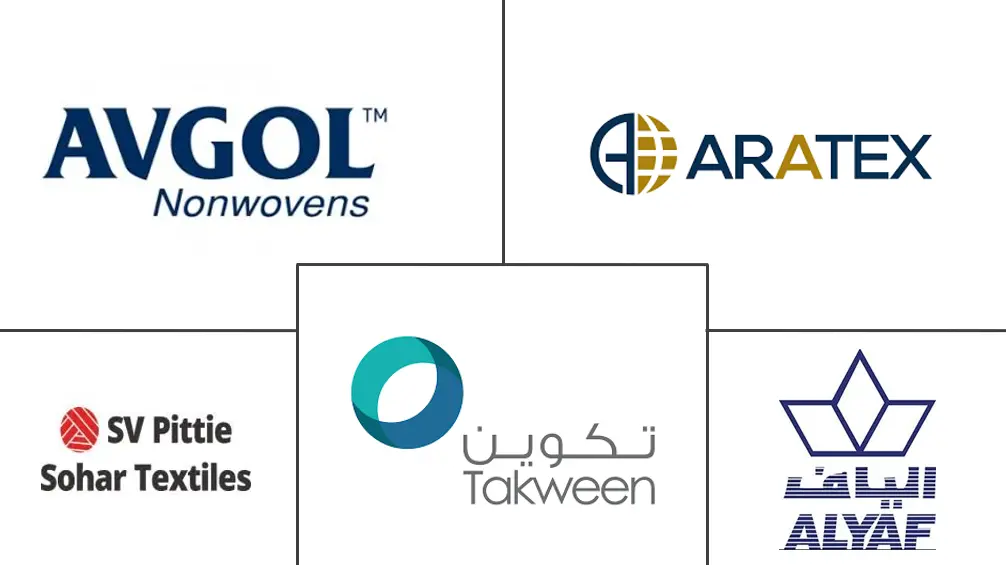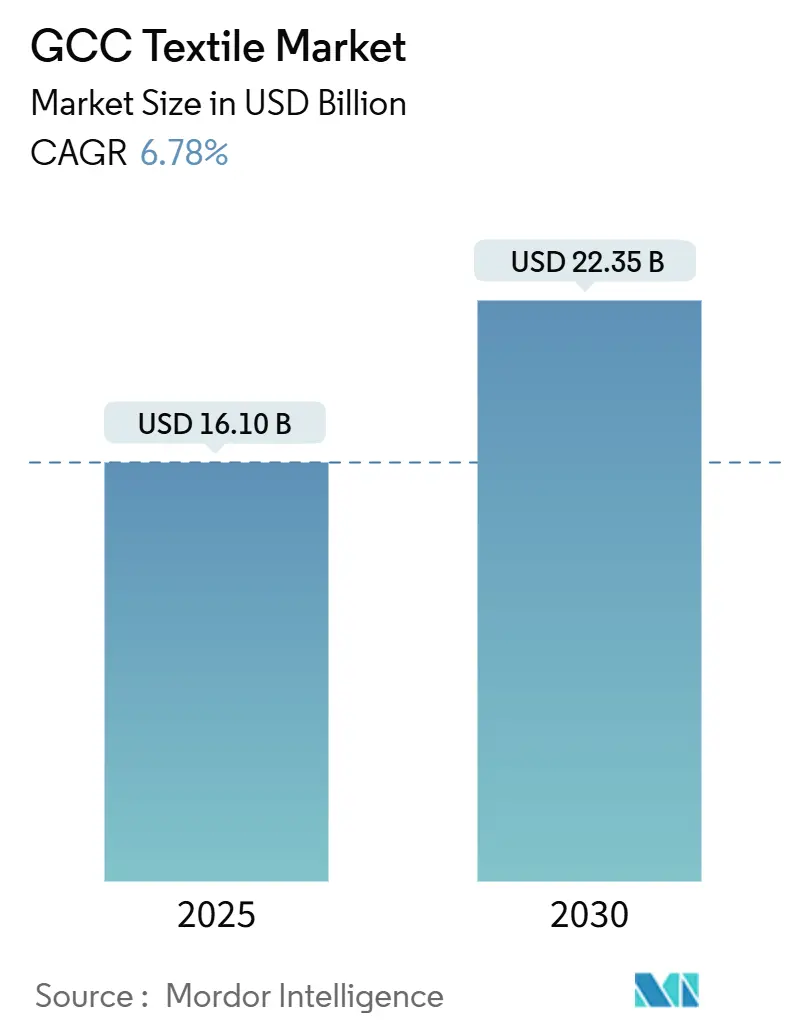
GCC Textile Market Analysis by Mordor Intelligence
The GCC Textiles Market size stood at USD 16.10 billion in 2025 and is forecast to climb to USD 22.35 billion by 2030, reflecting a robust 6.78% CAGR. Expanding discretionary incomes, government-backed industrial localization programs, and the region’s youthful demographics are reinforcing demand across apparel, technical, and home textile categories. Large-scale infrastructure projects continue to stimulate consumption of geotextiles and construction fabrics, while policy incentives under Vision initiatives are drawing foreign and domestic investors into local manufacturing. E-commerce gains, spearheaded by digitally savvy consumers, are shortening fashion cycles and heightening the need for agile production. Growing sustainability mandates and circular-economy targets are also shaping product development and sourcing decisions within the GCC textiles market.
Key Report Takeaways
- By application, fashion and apparel led with a 58.97% revenue share in 2024; industrial and technical textiles are projected to register an 8.14% CAGR through 2030.
- By raw material, synthetic fibers captured 49.87% of the GCC textiles market share in 2024, while polyester is expected to advance at an 8.55% CAGR to 2030.
- By process, woven textiles held 52.65% of the GCC textiles market size in 2024, and non-woven technologies are set to grow at an 8.04% CAGR during the forecast period.
- By geography, Saudi Arabia commanded 37.67% of 2024 revenue, whereas Oman is forecast to post the fastest 7.79% CAGR through 2030.
GCC Textile Market Trends and Insights
Drivers Impact Analysis
| Driver | (~) % Impact on CAGR Forecast | Geographic Relevance | Impact Timeline |
|---|---|---|---|
| GCC industrial-diversification incentives (Vision programs) | +1.8% | Saudi Arabia, UAE, Qatar | Long term (≥ 4 years) |
| E-commerce-driven fast-fashion demand | +1.5% | Regional, led by Saudi Arabia and UAE | Short term (≤ 2 years) |
| Growing fashion-conscious youth population | +1.2% | GCC-wide, strongest in UAE and Saudi Arabia | Medium term (2-4 years) |
| Mega-project demand for technical & geotextiles | +0.9% | Saudi Arabia, UAE, Qatar | Medium term (2-4 years) |
| Hub-and-re-export advantage via UAE free-zones | +0.7% | UAE-centric with regional spillover | Short term (≤ 2 years) |
| Circular-economy & recycling mandates | +0.6% | GCC-wide, led by UAE and Saudi Arabia | Long term (≥ 4 years) |
| Source: Mordor Intelligence | |||
GCC Industrial-Diversification Incentives (Vision Programs)
National transformation agendas are channeling capital and policy support toward non-oil manufacturing. Saudi Arabia’s Vision 2030 industrial strategy offers subsidized land, streamlined licensing, and preferential financing for textiles firms that localize production in economic cities. The UAE’s Operation 300bn and Qatar’s National Vision 2030 echo this blueprint, coordinating funding for technology adoption, workforce upskilling, and public-private partnerships. By backstopping capex and easing regulatory friction, these programs bolster investor confidence and accelerate the deployment of advanced weaving, knitting, and non-woven lines. Over the long term, such initiatives are expected to lift value-added output, reduce reliance on imports, and expand the GCC textiles market’s export footprint[1]Ministry of Industry and Mineral Resources, “Industrial Strategy Update 2025,” mim.gov.sa.
E-Commerce-Driven Fast-Fashion Demand
Digital channels are reshaping go-to-market strategies across the GCC textiles market. Omni-channel leaders such as Landmark Group report that online sales already account for one-fifth of total turnover, supported by a USD 350 million automated distribution hub in Jebel Ali that handles more than 20,000 packages daily. Seamless payment systems, same-day delivery options, and mobile-first interfaces are raising customer expectations for speed and variety. Smaller garment makers now access cross-border buyers without heavy brick-and-mortar investment, multiplying competitive intensity. Rapid replenishment cycles require near-shoring of certain product lines, spurring interest in localized cut-make-trim operations across UAE free zones and industrial parks in Saudi Arabia.
Growing Fashion-Conscious Youth Population
A sustained demographic dividend is anchoring long-term demand in the GCC textiles market. Roughly 62% of the region will remain of working age through 2050, creating a large cohort with rising disposable income and a penchant for contemporary styles. Social-media influence and global fashion connectivity are accelerating style adoption, prompting brands to refresh collections more frequently. Domestic producers that pivot toward quick-response manufacturing and trend-aligned designs are positioned to capture higher margins. Urban hubs such as Dubai, Riyadh, and Doha demonstrate an especially strong appetite for premium and modest apparel formats. This youth-led consumption underpins steady volume growth and encourages continued investment in regional design and production capacity.
Mega-Project Demand for Technical & Geotextiles
Record infrastructure spending continues to fuel industrial textile uptake. Projects like NEOM in Saudi Arabia and Port of Dubai expansions require vast quantities of geotextiles for soil stabilization, drainage, and environmental protection. Construction fabrics, protective clothing, and filter media similarly benefit from the region’s pipeline of airports, railways, and smart cities. Government procurement rules that favor local content are encouraging global technical-textile specialists to form joint ventures or license technology to GCC manufacturers. These orders are sizable, long-term, and less price sensitive than apparel contracts, providing steady revenue streams and diversification for producers.
Restraints Impact Analysis
| Restraint | (~) % Impact on CAGR Forecast | Geographic Relevance | Impact Timeline |
|---|---|---|---|
| Raw-material price volatility (cotton, synthetics) | -1.1% | GCC-wide, import dependent | Short term (≤ 2 years) |
| Intense import competition from low-cost Asian suppliers | -0.9% | Region-wide, highest in Saudi Arabia and UAE | Medium term (2-4 years) |
| Skilled-workforce shortages in manufacturing | -0.6% | Manufacturing hubs in Saudi Arabia, UAE, Bahrain | Long term (≥ 4 years) |
| SASO-/Saber-related compliance costs | -0.4% | Saudi Arabia primary, regional spillover effects | Medium term (2-4 years) |
| Source: Mordor Intelligence | |||
Raw-Material Price Volatility (Cotton, Synthetics)
Cotton prices remain vulnerable to weather disruptions and shifting acreage, with the USDA forecasting tighter ending stocks versus consumption in 2025. Spot quotes above historical norms amplify working-capital needs for GCC textile mills that import nearly all natural fiber inputs. Synthetics show similar swings when oil or feedstock costs spike. Currency fluctuations and freight surcharges further complicate procurement planning. Manufacturers hedge through diversified sourcing and inventory buffers, yet sudden surges compress margins and force price renegotiations with buyers. Persistent volatility, therefore, weighs on profitability and can slow capacity expansion decisions across the GCC textiles market[2]United States Department of Agriculture, “Cotton and Wool Outlook,” usda.gov.
Intense Import Competition from Low-Cost Asian Suppliers
Asia remains the world’s spinning and apparel nucleus, giving exporters from China, Vietnam, Bangladesh, and India formidable economies of scale. Favorable wage structures and integrated supply chains enable aggressive pricing that challenges GCC factories, especially in commodity categories such as basics and uniforms. Tariff concessions under various bilateral pacts widen the gap. To defend share, regional producers are migrating toward higher-value niches, investing in automation to trim labor costs, and marketing “Made in GCC” authenticity for speed-to-shelf advantages. Nonetheless, sustained undercutting by Asian rivals tempers price realization and restrains some investment in the GCC textiles market.
Segment Analysis
By Application: Fashion Leads as Technical Textiles Accelerate
Fashion and apparel generated 58.97% of the GCC textiles market size in 2024 on the back of retail network expansion and brand diversification. Department stores and malls in Riyadh, Jeddah, Dubai, and Doha widened their assortment to capture youth and expatriate spending. International labels increasingly adopt franchise or joint-venture formats that require localized supply of trims, labels, and select garment ranges. Digital retailers deploy data analytics to forecast trends, prompting contract manufacturers to shorten batch runs and adopt modular production. Meanwhile, industrial and technical textiles are projected to clock the fastest 8.14% CAGR through 2030 as mega-projects demand geotextiles, filtration media, and flame-retardant fabrics. Local suppliers that secure compliance certifications gain a first-mover advantage, and partnerships with engineering firms unlock bundled project bids.
Rising health-and-wellness awareness is lifting sales of medical textiles, including disposable gowns and wound-care dressings, though volumes remain modest relative to apparel. Home textiles such as bed linens and curtains benefit from residential real-estate developments and hospitality refurbishments ahead of high-profile events. Automotive textiles gain from seat-fabric and airbag applications as regional assembly ventures scale. Altogether, the widening application mix lessens revenue seasonality and supports resilience in the GCC textiles market.
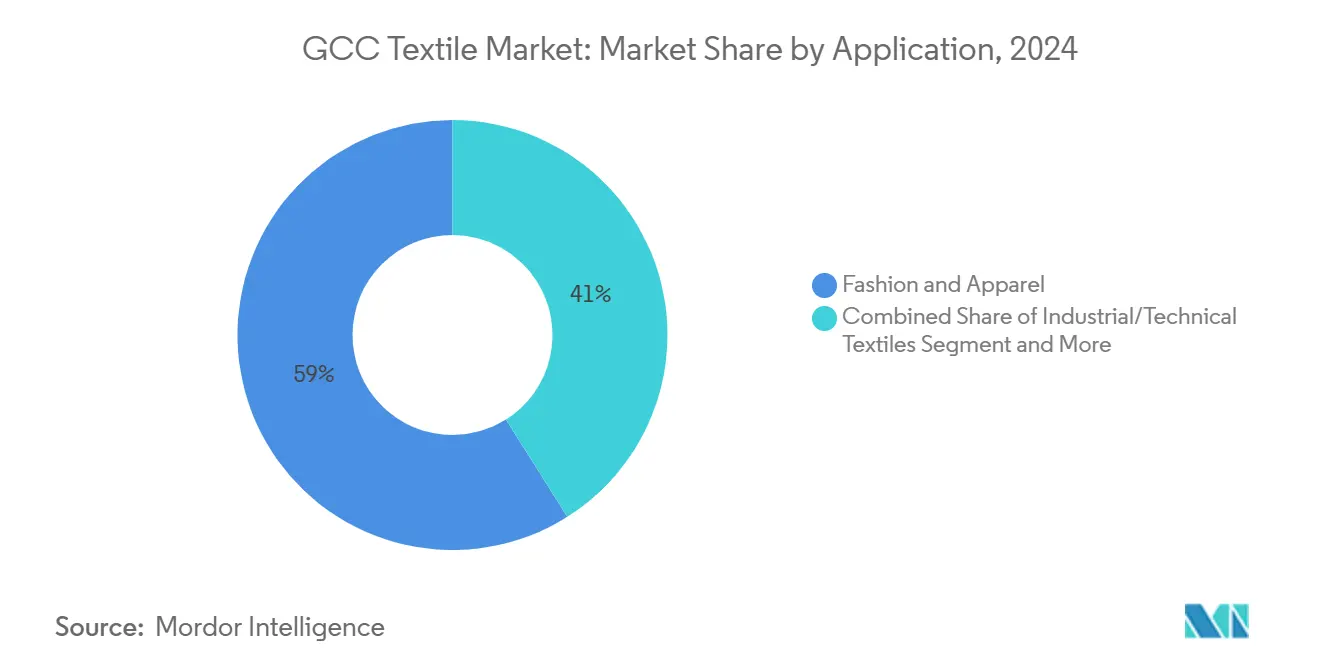
Note: Segment shares of all individual segments available upon report purchase
By Raw Material: Synthetic Fibers Dominate, Polyester Takes the Baton
Synthetic fibers secured 49.87% of overall revenue in 2024, reflecting steady availability, competitive cost, and versatility across apparel and technical uses. Polyester stands out with an 8.55% CAGR forecast, bolstered by demand for moisture-wicking sportswear and durable construction fabrics. Post-consumer PET-bottle recycling initiatives in UAE free zones are creating feedstock for recycled polyester, aligning with circular-economy mandates and bolstering local sourcing credibility. Cotton remains culturally significant, especially for traditional attire, yet sourcing risks tied to global weather patterns and geopolitical trade tensions curb overreliance. Consequently, brands blend cotton with synthetics to balance comfort and cost.
Specialty fibers such as aramid and carbon address high-performance niches in fire safety, defense, and aerospace. Although these account for small tonnage, margins are attractive, spurring joint ventures with global chemical firms. Wool and silk serve luxury segments, underpinned by premium positioning in national dress and gifting markets. Recycled fibers, though embryonic, garner policy support under waste-reduction goals, preparing the GCC textiles market for growing eco-label requirements from overseas buyers.
By Process: Woven Heritage Meets Non-Woven Innovation
Woven textiles retained 52.65% of the GCC textiles market share in 2024 thanks to entrenched looms, skilled operators, and longstanding trade in sheeting, denim, and shirting. Investments in air-jet and rapier machines have trimmed cycle times and improved fabric uniformity. Yet non-woven output is forecast to expand at an 8.04% CAGR as hygiene, medical, and filtration applications proliferate. Melt-blown and spun-bond lines installed in the UAE and Saudi Arabia since 2023 target local PPE demand and export orders to Europe and Africa. Producers leverage polymer integration with regional petrochemical clusters to secure resin supply and cost advantages.
Knitted fabric producers cater to athleisure and lingerie segments, adopting circular knitting machines for seamless garments that reduce post-production wastage. 3-D weaving and spacer fabrics, though nascent, attract R&D grants from government innovation funds, paving the way for lightweight composites in transport and construction. Process diversification, therefore, enhances value capture and reduces dependence on conventional cotton weaving cycles.
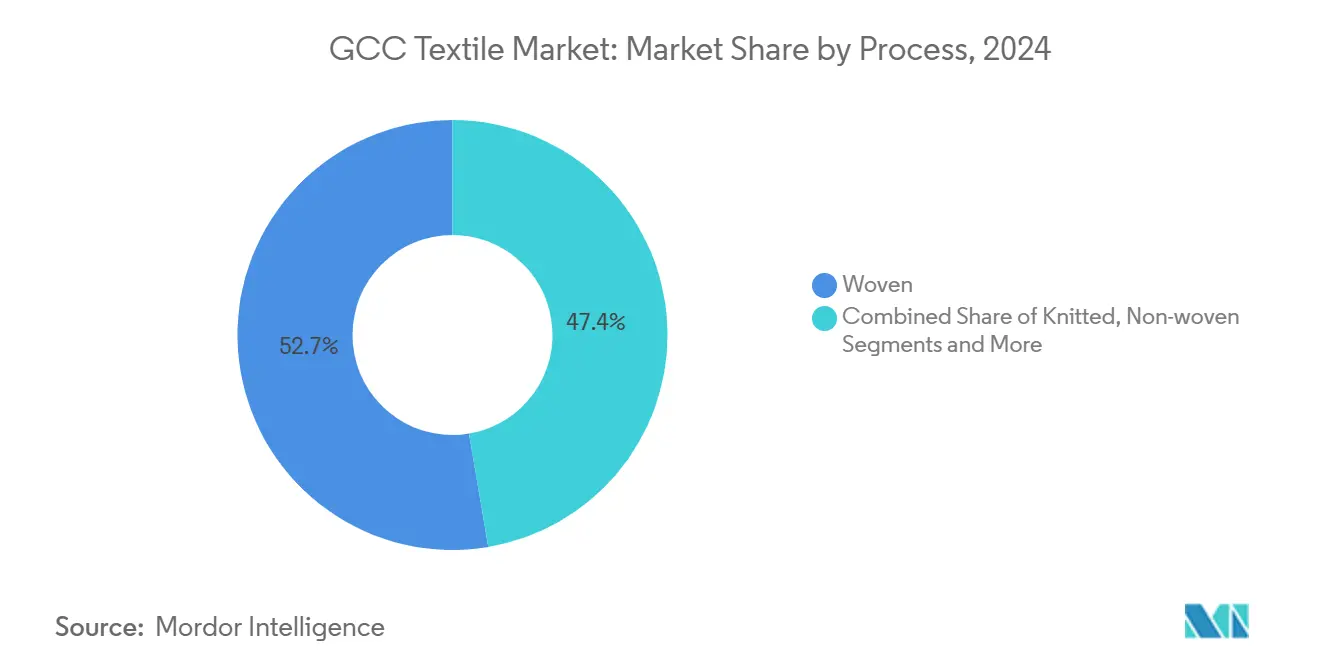
Note: Segment shares of all individual segments available upon report purchase
Geography Analysis
Saudi Arabia’s 37.67% revenue share in 2024 underscores its status as the linchpin of the GCC textiles market. Vision 2030 industrial clusters in Jubail, Yanbu, and Jazan provide subsidized utilities, bonded warehousing, and expedited customs, attracting regional and global textile groups. Mandatory SASO certification elevates product quality, allowing local producers to command premium slots in domestic retail. The country’s giga-project pipeline, led by NEOM, supplies long-dated off-take agreements for geotextiles and protective fabrics. Rising middle-class incomes and nationwide mall development foster sustained demand for branded fashion, giving manufacturers a balanced portfolio of consumer and industrial orders.
The UAE ranks second, leveraging Jebel Ali Free Zone’s port-centric ecosystem that enables duty-free storage, light assembly, and rapid re-export to more than 150 countries. Dubai continues to position itself as the region’s fashion showcase through events such as Dubai Fashion Week, boosting demand for limited-edition and luxury fabrics. Abu Dhabi’s Khalifa Industrial Zone integrates polymer feedstock from ADNOC, offering petro-textile synergies that appeal to polyester yarn extruders. Multimodal connectivity reduces lead times to Europe and East Africa, making the Emirates a preferred consolidation point for omnichannel retailers restocking multiple GCC markets.
Oman, while smaller in absolute terms, is projected to log the fastest 7.79% CAGR through 2030, propelled by industrial diversification policies under Vision 2040. The Sohar Free Zone’s proximity to Asia-Europe shipping lanes and competitive utility pricing attract spinners and non-woven converters targeting both GCC and East African buyers. Government grants for SME manufacturing foster domestic sewing units that supply school uniforms and workwear. Qatar, Kuwait, and Bahrain each carve niche positions: Qatar leverages post-World-Cup infrastructure spend to order technical fabrics; Kuwait supports home-textile demand through residential development; Bahrain focuses on value-added finishing within its long-standing apparel clusters. Collectively, the geographic mosaic enables manufacturers to allocate capacity according to cost structures, regulatory regimes, and end-market proximity, thereby optimizing the GCC textiles market footprint[3]GCC Secretariat General, “Communiqué of the 163rd Ministerial Council,” gcc-sg.org.
Competitive Landscape
Competition in the GCC textiles market balances regional incumbents, international majors, and agile start-ups. Domestic groups such as Tasnee and Al-Safy Textiles augment backward integration into petrochemicals or yarn spinning to secure raw-material stability. Global brands, including Toray and Hyosung, form joint ventures to share technology and qualify for local-content incentives. Mid-tier apparel makers differentiate via quick-turn, small-lot production for digital retailers, leveraging near-shoring to beat Asian rivals on lead time rather than on cost alone.
Strategic activity has intensified since 2023. Landmark Group committed USD 1 billion to expand omnichannel retail and local sourcing, reinforcing regional demand pull. Amethis Capital acquired a controlling stake in Kazareen Textile Group in 2025, signaling private-equity appetite for multiregional consolidation and operational upgrades. Poly-to-filament projects in Saudi Arabia benefit from feedstock offtake agreements with petrochemical majors, insulating yarn mills from price swings in global PTA markets. Meanwhile, European technical-textile specialists license IP to GCC converters, capturing growth without heavy capex.
Sustainability and digitalization emerge as central themes. Producers pilot blockchain-enabled traceability to satisfy ESG audits, while modular automated sewing units cut labor reliance and improve consistency. Investment in solar rooftops and water-recycling units supports green credentials that resonate with global buyers. As the market matures, players able to combine low-carbon operations, rapid design turnaround, and compliance with tightening circular-economy rules are set to command a higher share and pricing power within the GCC textiles market.
GCC Textile Industry Leaders
-
Alyaf Industrial Co. Ltd.
-
SV Pittie Sohar Textiles
-
Takween Advanced Industries
-
Aratex Group
-
Avgol Middle East
- *Disclaimer: Major Players sorted in no particular order
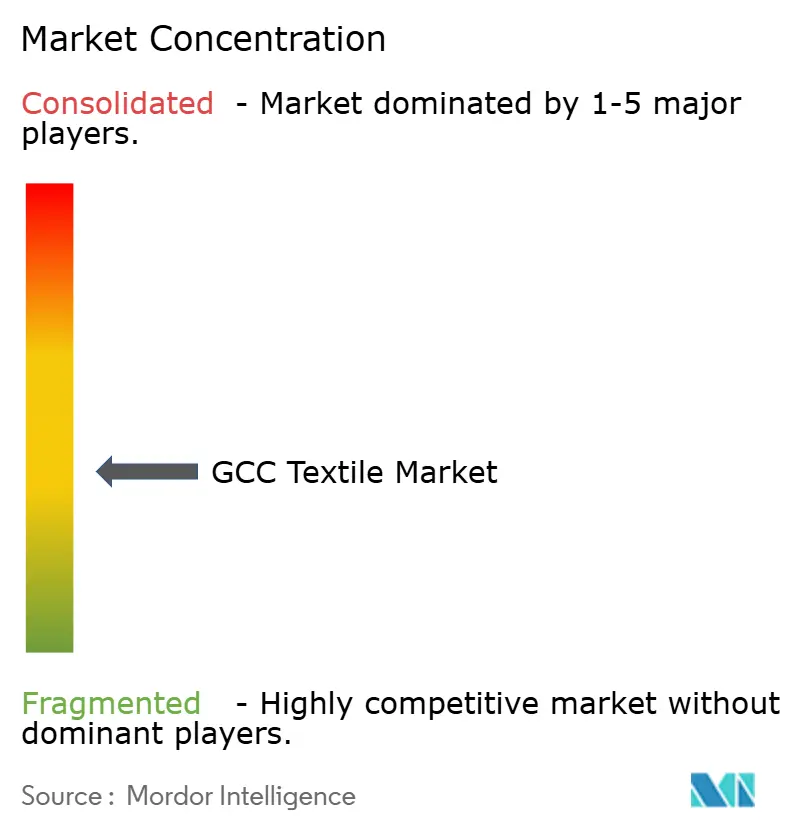
Recent Industry Developments
- May 2025: Saudi Arabia’s Ministry of Industry and Mineral Resources unveiled a refreshed Vision 2030 industrial roadmap detailing tax incentives, vocational training schemes, and technology grants for textile investors.
- March 2025: The GCC Ministerial Council’s 163rd Session endorsed deeper economic integration and earmarked reconstruction funding channels that may create humanitarian textile procurement opportunities in conflict-affected neighboring states.
- February 2025: Amethis Capital acquired a majority stake in Kazareen Textile Group, adding GCC production sites to the company’s network in Africa, Europe, and North America to build a vertically integrated supply platform.
- November 2024: Landmark Group announced a USD 1 billion program to open 400 additional stores across GCC, India, and Southeast Asia by 2028 and to elevate e-commerce capabilities through a new fulfillment hub in Riyadh.
GCC Textile Market Report Scope
Textiles are materials or fabrics that are made of tiny fibers that can be natural or man-made, and those fibers are then twisted into yarns. Textiles are created by interlocking these yarns in specific patterns, resulting in a length of cloth. Textiles can be classified as natural textiles and synthetic textiles. The GCC Textile Market is segmented by application (Clothing, Industrial/Technical, and Household), by material type (Cotton, Jute, Silk, Synthetics, and Wool), and by process (Woven and Non-Woven). The report offers the market size and forecasts for the GCC textile market in value (USD billion) for all the above segments.
| Fashion & Apparel |
| Industrial/Technical Textiles |
| Household & Home Textiles |
| Medical & Healthcare Textiles |
| Automotive & Transport Textiles |
| Others (Protective, Sports Textiles, etc.) |
| Natural Fibers | Cotton |
| Wool | |
| Silk | |
| Synthetic Fibers | Polyester |
| Nylon | |
| Rayon / Viscose | |
| Acrylic | |
| Polypropylene | |
| Recycled Fibers | |
| Others (Speciality High-Performance Fibers (Aramid, Carbon, UHMWPE)) |
| Woven | |
| Knitted | |
| Non-woven | Spunlaid (Spunbond / Melt-blown) |
| Dry-laid Hydro-entangled | |
| Wet-Laid | |
| Needle-punched | |
| 3-D Weaving & Spacer Fabrics |
| Saudi Arabia |
| United Arab Emirates |
| Qatar |
| Kuwait |
| Oman |
| Bahrain |
| By Application | Fashion & Apparel | |
| Industrial/Technical Textiles | ||
| Household & Home Textiles | ||
| Medical & Healthcare Textiles | ||
| Automotive & Transport Textiles | ||
| Others (Protective, Sports Textiles, etc.) | ||
| By Raw Material | Natural Fibers | Cotton |
| Wool | ||
| Silk | ||
| Synthetic Fibers | Polyester | |
| Nylon | ||
| Rayon / Viscose | ||
| Acrylic | ||
| Polypropylene | ||
| Recycled Fibers | ||
| Others (Speciality High-Performance Fibers (Aramid, Carbon, UHMWPE)) | ||
| By Process / Technology | Woven | |
| Knitted | ||
| Non-woven | Spunlaid (Spunbond / Melt-blown) | |
| Dry-laid Hydro-entangled | ||
| Wet-Laid | ||
| Needle-punched | ||
| 3-D Weaving & Spacer Fabrics | ||
| By Geography | Saudi Arabia | |
| United Arab Emirates | ||
| Qatar | ||
| Kuwait | ||
| Oman | ||
| Bahrain | ||
Key Questions Answered in the Report
What is the current value of the GCC textiles market?
The sector generated USD 16.10 billion in 2025 and is on track to reach USD 22.35 billion by 2030.
Which segment holds the highest share within GCC textiles?
Fashion and apparel leads with 58.97% of 2024 revenue, reflecting strong consumer demand across major cities.
Which raw material is growing fastest in regional production?
Polyester, a synthetic fiber, is projected to expand at an 8.55% CAGR through 2030 due to demand for durable, moisture-wicking fabrics.
Which country is the largest contributor to GCC textiles revenue?
Saudi Arabia accounts for 37.67% of total market turnover, supported by Vision 2030 industrial incentives and a sizable consumer base.
How fast is the overall GCC textiles market expected to grow?
The market is forecast to post a 6.78% CAGR between 2025 and 2030 as diversification programs and e-commerce adoption stimulate demand.
What challenges do regional manufacturers face?
Key headwinds include raw-material price swings and stiff price competition from low-cost Asian exporters.
Page last updated on:
